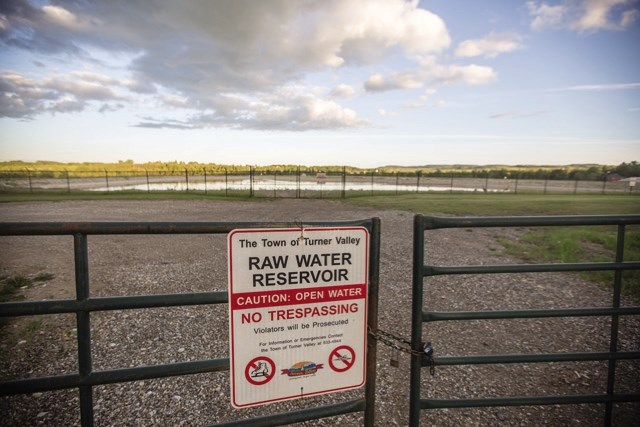Two High Country communities are making significant progress in solving issues that have been draining their water for months.
Last spring, the Towns of Black Diamond and Turner Valley feared they would have to restrict residents from outdoor water use due to declining levels in the raw water reservoir, but action taken the past few months is making a difference.
Barry Williamson, Turner Valley chief administrative officer, said fixing water leaks in both communities and replacing about 250 outdated water metres in Turner Valley has meant the raw water reservoir used by both towns has remained at full capacity since August.
“It was a combination of fixing some issues in terms of infrastructure as well as the river recovering and the wells therefore recovering,” he said. “There was some water leaks between the towns that got fixed. It was primarily on the Black Diamond side.”
The replacement of the water metres helped to bring down water loss because several metres exceeded their life expectancy and weren’t working adequately, said Williamson
Another 100 are slated to be replaced between now and the beginning of next year, Williamson said.
“There was water being used, but not billed for,” he said. “We showed a significant loss and it’s improved immensely. We are closing the gap.”
He expects this will result in higher water bills.
“As people get billed for it they might get a lot smarter in how they’re using their taps and there might be a slight drop in revenue,” he said. “People will start to realize, ‘I am using more water than I thought’ and they will start to get closer to what the average household uses. There will be a behavioural change.”
At the beginning of 2016, more than 30 per cent of water being used in Black Diamond and Turner Valley was not being billed for, said Williamson.
“The water we weren’t billing for wasn’t so much water lost in the ground it was water going into households because the metres weren’t working very well,” he said. “The water that wasn’t billed for was lost income. Financially, we were obviously eating that loss so a portion was recovered through the property taxes.”
Williamson said that loss is now at 18 per cent, just three per cent higher than what is considered average by engineers.
He added that the Town of Turner Valley has been replacing water lines that reach their life expectancy regularly.
“We did do a lot of renewal in Turner Valley over the last number of years,” he said.
Through ongoing infrastructure work and keeping water metres up to date, Williamson hopes water loss won’t be an issue in the future.
Sharlene Brown, Black Diamond chief administrative officer, said the Town repaired the five water leaks that were identified over the summer, contributing to the overall decline.
“I think we’ve done a really good job,” she said. “Looking at 2017 and 2018 replacement and revitalization of infrastructure is going to be very important.”
Both communities maintained their water restrictions at level 2 throughout the summer, which restricts outdoor water use for such activities as watering lawns and washing siding and driveways, to certain days.
Brown expects the restrictions will remain at level 2 throughout the next several months, although overall water use typically drops significantly from the summer months.
“Level 2 is really the new way of doing business for many communities,” she said. “I’m not saying it’s going to be that way for ours, but there’s off and on watering days in many communities. Okotoks does that as a standard course of business and it does not cause any hardships on anybody.”
Brown said there may be some discussions regarding what water restrictions might look like in the two communities in the future.
After restrictions were put on residents and businesses in both communities for several months prohibiting any outdoor water use following the 2013 flood in southern Alberta, both Williamson and Brown have found residents have been diligent with conserving water ever since.
“I congratulate the community for sticking with us and ensuring we all use our natural resources wisely,” Brown said.




